Resolver
Resolver
The resolvers have been the only technology of choice for reliably providing position feedback under very harsh environments. Most efforts that have been made to resolvers so far are improving the position sensing accuracy while reducing the manufacturing difficulties within the same framework that is based on the configuration of even number coil-poles to sense the two-phase orthogonal displacement signals directly, which has not been changed since the inception of the resolver.
ZF Resolver has completely new architecture composed of the multiphase resolver body and the signal processing block. The multiphase variable reluctance (VR) resolver body is configured to have odd number coil-poles, and from which sequentially phase-delayed odd number sinusoidal signals are sensed as the rotor rotates. The two-phase orthogonal displacement signals are synthesized from the sensed multiphase signals by the ZF transform. With the multiphase VR resolver body being configured to have odd number coil-poles and sensed single type signals, a fine 1X VR resolver is readily feasible. By changing the rotor lobe shapes, the variety of kX speed VR resolver body are flexibly constructed under the same stator.
Because of its symmetric and simple topology of the multiphase VR resolver body, balanced magnetic flux state is naturally achieved, and coil winding tasks are substantially minimized. The multiphase signal processing technique also allows to introduce the digital type signal sensing by equipping the rotor having the quasi-square waveform rotor lobes.
The ZF resolver architecture can be applied to the wound rotor (WR) resolvers, variable inductance (VI), and capacitive resolvers in the same manner. In the ZF WR resolvers, complicated skewed core design is mitigated, and very simple WR resolvers are achievable.
ZF Resolver Architecture
- N-phase Displacement Signals are Sensed from the Resolver Body
- Sine and Cosine Signals are Synthesized by the ZF Transform

Typical VR Resolver vs. ZF Resolver
- Typical VR Resolver
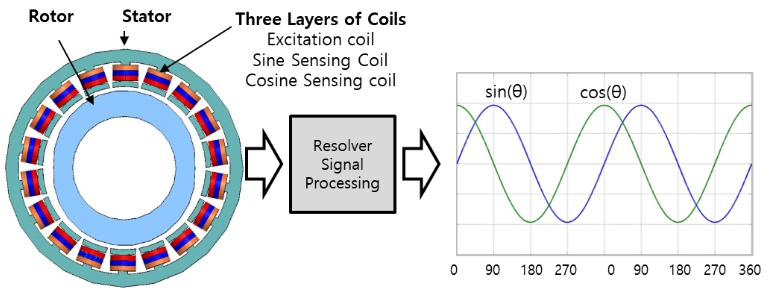
- ZF VR Resolver

Comparison between the ZF VR Resolver Body and the typical VR Resolvers
- ZF VR resolver body is configured to have odd number coil-poles, which are excited in parallel, whereas the typical VR resolvers generally have even number coil-poles, which are connected in serial.
- Single coil is wound on each coil-pole for the purpose of exciting and sensing, whereas in the typical VR resolvers, generally three types of coils are overlappingly wound on each coil-pole.
- All coils have the same number of turns and identical electrical polarity, whereas in the typical VR resolvers, generally the number of coil turns varies from pole to pole and depends on the signal type of coils with the varying winding direction
- Carrier amplitude under-modulation is allowed, whereas under-modulation is not allowed in the typical VR resolvers.
Attribute | Typical VR Resolvers | ZF VR Resolver | Advantages |
# of Coil-Poles | Even Number | Odd Number | 1X Absolute VR Resolver is Feasible |
Coil Windings | Three Layers of Coil Windings | Single Coil Winding | Significantly Reducing Manufacturing Cost |
Number of Coil Turns | Depends on Coil Type and Varies Pole to Pole | Same Number of Turns for all Coils | Reducing Coil-Winding Cost |
Coil Direction | Changing Polarity | Same Polarity | Reducing Coil-Winding Tasks |
Modulation Index | 100% Amplitude Modulation Index Required | Under Modulation is Allowed | Reducing Manufacturing Cost |
1X VR Resolver
- Real Absolute 1X VR Resolver
- Easy to Manufacturing and Flexible kX Speed under the same Stator configuration
- Just Change the Rotor Lobe Saliency, 1X ~ kX.
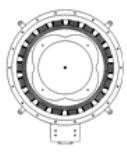
Typical 1X VR Resolver
Hard to Match Stator and Rotor Saliency
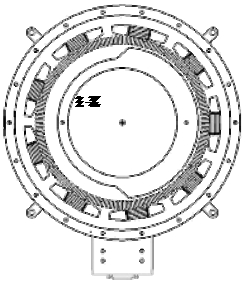
ZF 1X VR Resolver Body
Ordinary Rotor with 1X Saliency
Rotor Lobe with Quasi-Square Waveform Saliency
- Reduced the Manufacturing Cost compared with the Sinusoidal-Waveform Rotor Lobe
- ZF Transform Processes the Sensed Quasi-square Waveform Signals, and Produces the Stair Stepped Sine and Cosine Signals
- Orthogonality is Held between the Stair Stepped Sine and Cosine Signals
- Extremely Robust under Heavy Impairments and Noise
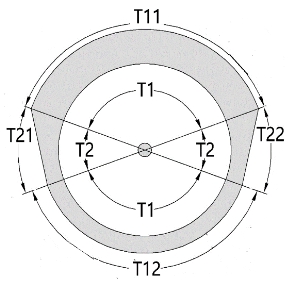
1X Quasi-square Waveform Rotor Lobe
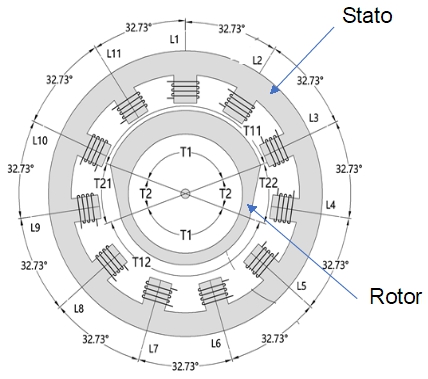
11-Phase VR Resolver Equipped with the 1X Quasi-square Waveform Rotor Lobe
ZF WR Resolver
- Harmonic Distortions in the Sensed Signals are Removed in the process of the ZF transform
- No Need Skewed Core Design, Damper Winding, or Intricated Coil-Poles Distribution
- Super Flat and Precise WR Resolvers
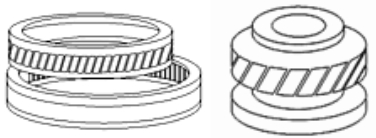
Typical WR Resolvers
Thick/Heavy
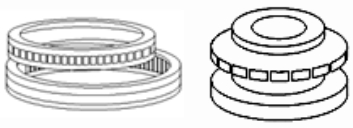
ZF WR Resolvers
Thin/Light
ZF VI Resolver
- Characteristic of Odd Number Poles of VR Resolver Topology Enables to Build Noble Inductive Resolvers
- Magnetic Flux Generated from Each Coil-Pole does NOT Interfere with Other Coil-Poles
- Each Coil-Pole is Separated from Other Coil-Poles
- Stator Body is Non-contiguously Constructed
